It’s that time of year… office parties, marathon Christmas card writing sessions, last minute shopping sprees and, inevitably, the dread of receiving another pair of unwearable festive socks… This year, though, it could be very different: why not drop a few hints and see if your loved ones will seek out a pair of high performance socks to take on this winter’s ski trip?
Socks are frequently one of the most overlooked pieces of a skier’s basic kit — a huge mistake when a decent pair can make a huge difference to your experience in the mountains. The humble ski sock has come a long way indeed in the last decade. Sock scientists (yes, that’s a real job title!) are busy beavering away in the Alps and Rockies perfecting the art of manufacturing toasty, ergonomically designed and supremely comfortable socks that can really enhance your skiing enjoyment. Choosing a good pair of socks is just as important as any other item of your base layer: skiers have enough on their minds navigating the slopes without the addition of blisters and foot discomfort to worry about!
Navigating your way through the vast selection of socks on offer may seem a little daunting: nowadays you can choose between regular and compression type socks; ‘lite’ and comfort models.. and there are even producers speccing socks designed to meet the needs of specific skiing skill levels! It’s not just marketing hype: a beginner skier is more likely to require additional padding and warmth, as they’re generally less nimble on the ski hill. More advanced skiers, on the other hand, exert more energy and more often require a sock that’s geared toward improving control and aiding their skiing performance: the more hi-tech offerings incorporate newly developed fibres that aim to improve muscle response and proprioception.
The design and construction, as well as the materials used in a sock’s fibres, are the principal factors influencing their feel and performance. Organic fibres such as silk and wool (merino wool being especially popular amongst manufacturers for its softness combined with excellent durability) have exceptional warmth to weight ratios, but however are not as effective at moisture wicking compared to modern synthetic fibres such as nylon and Lycra. A good pair of ski socks should provide for moisture-wicking to transfer perspiration outward and away from the foot, thus avoiding the clamminess that over time will promote skin irritation and discomfort. Synthetic fibres can also be engineered with a high elasticity, ensuring the sock remains in place and fits well despite vigorous movement and strenuous exercise. Increasingly, many designers are therefore selecting different fibres to be utilised in specific areas of the sock to maximise its function and performance.
Thick wool socks are for many skiers the go-to reliable default, but you might find them a little too bulky and uncomfortable in warmer weather. However, today’s ultralight models perform exceptionally well (particularly as regards moisture wicking) and function better in tighter fitting high-end boots: do consider trying a pair rather than simply selecting a thicker, more padded sock with the idea they’ll necessarily be more comfortable on the ski hill.
We’ve highlighted below a selection of the best quality ski socks that incorporate a range of different features that aim to maximise performance, comfort and durability. We recommend a little experimentation: as everyone’s physiology, including feet, are different, there’s no substitute for trying on a pair and seeing how your feet fare.
What to look for
As with any ski gear, functional and comfortable ski socks are key to getting the most out of your time on the mountain, whatever the weather conditions. After buying skis, boots, poles, goggles, a helmet (the list goes on and on!) socks are often something of an afterthought. However, comfortable feet are absolutely crucial to the skiing experience (this might seem self-evident!), but it’s amazing how many people will splash out on high-end boots and custom footbeds, then skimp on sock selection.
Whilst a key element to choosing the correct pair of socks is the balance between warmth and breathability, you should also consider that different temperatures on the hill will require you to have at least a couple of different thicknesses to choose from. Unlike other kit, socks are relatively cheap and therefore it’s easier to try out a few different pairs to find the ones you feel most comfortable with in particular weather conditions.
Key considerations in sock selection
FITTING
comfort is of course critical! The sock’s performance in terms of how it accommodates both stretch and mobility is an importance consideration. Excess bunching of the sock in the ski boot can result in friction and quickly cause blistering of hot spots on the skin.
WEIGHT
ski socks these days are available in various gauges/thicknesses to suit different levels of performance and exertion, and to allow for greater comfort in conjunction with changing temperatures on the mountain.
WARMTH
bare in mind that the intuitive notion that thicker socks are always warmest doesn’t hold true for every pair of socks: you should consider the need to have sufficient room within the boot to move your toes, aiding blood flow and improving circulation in the whole foot. Modern ski socks are generally thinner than in the past, in part due to major improvements in the design and materials used in ski boot liners, which have greatly aided both their fit and warmth. Blends of different fibres in the construction of the sock can make a huge difference here to comfort levels.
PADDING
padding can be placed in different areas of the sock to better manage the biomechanics pressures placed on the foot during skiing. Novices often choose socks with additional padding in the shins to reduce discomfort as they adapt to the specific demands placed on this area of a skier’s legs. Sock designers are now also experimenting with strategically placing padding on the soles too: if you select these, make sure they’ll function well with any custom footbeds you might already be using!
COMPRESSION
following with the general trend in sportswear, the main sock brands are now offering various compression models designed to help improve circulation by improving blood flow in critical areas of the foot: this can aid in promoting warmth and may also help reduce muscle fatigue. Certain higher end socks feature graduated compression in the toes to promote blood flow in this critical area for warmth. As with other items of compression wear worn for sports, the socks are very form fitting: the feeling they promote is one that you may love or hate! Comfort is a very personal matter, of course, so don’t fret if you find the tightness isn’t something you can adjust to — there are many others to choose from that will provide a cosier fit!
Selected Models
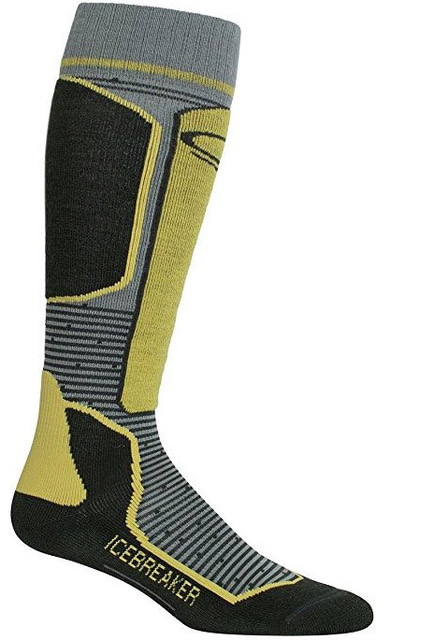
Materials: 70% Merino, 26% Nylon, 4% Lycra
NZ-based Icebreaker has been one of the industry's pioneers in the use of merino wool. The Icebreaker Ski+ Light sock offers a very high merino content to ensure warmth and guarantee
a silky smooth, luxurious feeling. The relatively light padding best suits more experienced skiers seeking extra warmth. These Icebreaker socks are sized for both men and women and are designed specifically for both the left and right feet — do take the time in the morning to make sure you've got them the right way round!
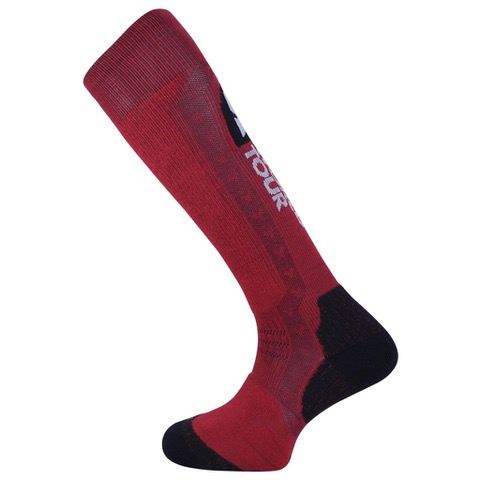 Teko Freeride Ski Socks Light Cushion £20
Teko Freeride Ski Socks Light Cushion £20
Materials: 35% Merino Wool, 23% Recycled Polyester, 42% Polyamide Nylon
TEKO’s Freeride socks feature organic Argentinian merino wool that’s itch-free and resists shrinkage. An added bonus of the selected blend is that it also resists odour absorption and is treated using a chlorine-free process: added environmental Brownie points, then! TEKO have also innovated in this sock design by using recycled synthetics, a process they’ve dubbed “SIN3RGI”. The blend has been used to create a faster drying, more durable sock with light cushioning under the foot and shin area. An added bonus of all TEKO products is that they feature a lifetime guarantee against any manufacturing faults.
Smartwool PhD Ski Light £22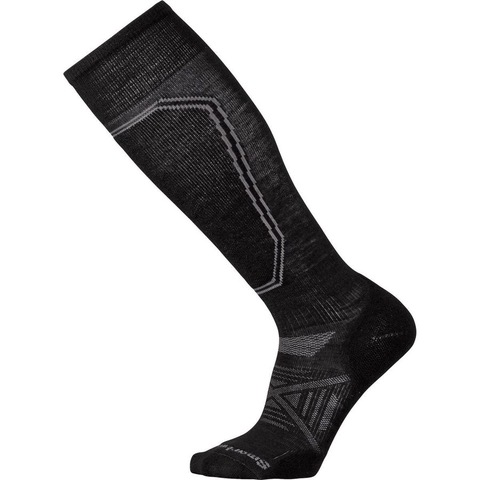
Materials: 56% Merino Wool, 42% Nylon, 2% Elastane
Smartwool have been one of the great innovators in the outdoor industry over the last decade. Their PhD range of socks (available in both men’s and women’s specific fits) are well established and have a great reputation for both comfort and durability, ensuring your feet will stay toasty warm for many seasons! The latest incarnation of these classic socks has improved cushioning on the shins along with additional cushioning on the bottom of the foot to increase warmth and impact protection. Smartwool have also designed into the sock its innovative ‘4 Degree Elite Fit’ which aims to reduce bunching and binding of the sock with the boot, further aiding comfort on long ski days.
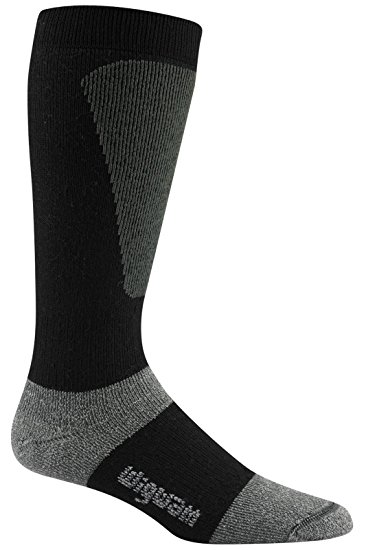
Wigwam Snow Sirocco Midweight Ski Socks £16
Materials: 40% Wool, 24% Nylon, 21% Polypropylene, 7% Polyester, 5% Olefin, 1% Spandex
These Wigwam socks feature a mid-weight cushion structure and are perfect for an intermediate level skier looking for a durable performance sock that won't break the bank. The Wigwams incorporate a lightly padded shin area for protection, coupled with calf cuff grips that aim to reduce snagging and hot spots. The addition of 24% nylon to the sock's construction further aids a snug fit. The high proportion of natural wool blended into the fabric ensures these Wigwam socks are also warm and resist odours through the anti-bacterial properties of the merino fibres.
Compression Socks
X-BIONIC Effektor Ski Advance Socks £64
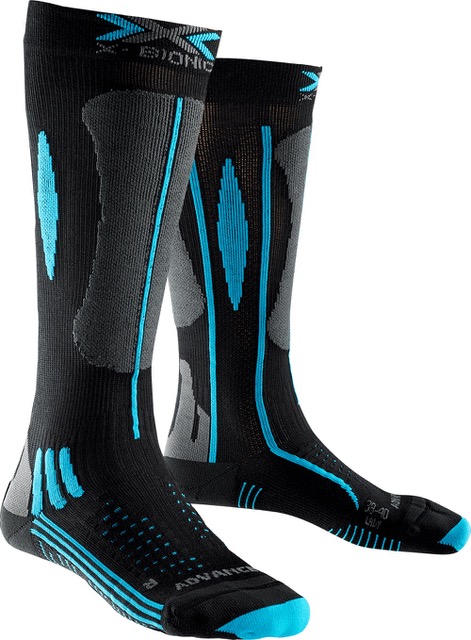
Materials: 38% Silk, 27% Polyamide, 23% Polyester, 9% Wool, 3% Elastane
As their name suggests, the Swiss-designed Effektor Ski Advance Socks are performance socks aimed at the more experienced skier. In fact, reading through the marketing spiel on the X-Bionic website, I’d suggest these are the Ferraris of tech ski socks: they feature an ‘Aktiv-Bund’ calf band to reduce slippage and bunching; an anatomically shaped 'Effektor footbed heel protector’; an instep protector with special 'AirVent Zone’ that is combined with a 'Traverse AirFlow Channel System' to promote moisture wicking. Impressive. You’ll want to take good care of these top notch accoutrements for your feet — at £64 per pair, we hope they’ll last a few seasons!
With such a large selection of great is socks on the market (and prints to suit every taste, however bizarre..) there’s no excuse for unhappy feet. A well chosen pair will ensure you reap the benefits all day long on the slopes this season!
 Off-Piste
Off-Piste Ski Touring
Ski Touring Via Ferrata
Via Ferrata Ice Climbing
Ice Climbing Alpine Glacier Trekking
Alpine Glacier Trekking Worldwide Trekking
Worldwide Trekking









 Travel Website Development
Travel Website Development